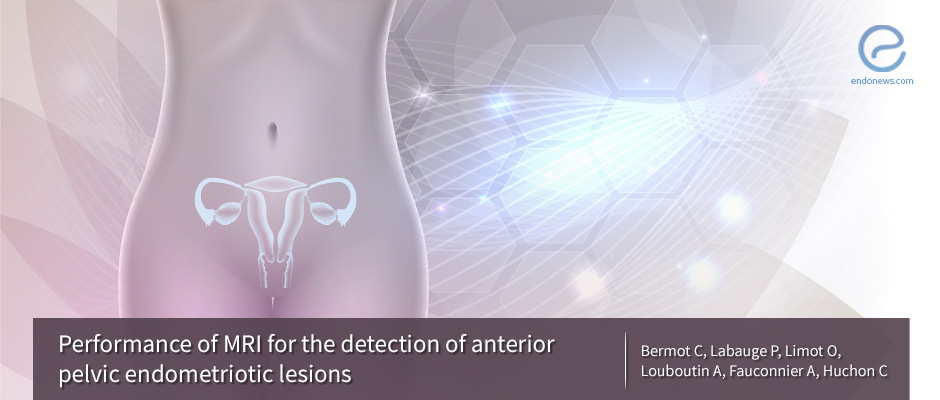Can MRI be used to detect anterior pelvic endometriotic lesions?
Nov 16, 2018
Magnetic resonance imaging (MRI) can be used as an alternative method to diagnose the anterior pelvic endometriotic lesions.
Key Points
Highlights:
- This retrospective case-controlled study evaluates the detection capacity of MRI in endometriotic lesions located in the anterior pelvic compartment.
- Deep infiltrating endometriosis can be located anywhere in pelvic cavity even less commonly in anterior compartment.
- These deep lesions can be diagnosed using transvaginal ultrasound and MRI. However, the definitive diagnosis is possible by surgery and histochemical investigation.
Importance:
- The preoperative mapping of the endometriotic lesions located in the anterior pelvic cavity with MRI and counseling of the patients is beneficial.
What’s done here?
- 256 patients underwent laparoscopic surgeryin a single center for deep endometriosis from 2005 to 2013 were included in this retrospective study.
- A total of 22 women had endometriotic lesions in anterior pelvic cavity according to their surgical findings.
- Authors included 22 age-matched controls who underwent laparoscopic surgery for deep endometriosis in the posterior pelvic cavity.
- 3 patients were excluded from the study group due to low quality MRI images.
- The preoperative MRI results of all these patients were evaluated blindly twice by two radiologists (junior and senior).
- These evaluations by radiologists were compared with the findings in laparoscopic reports. The sensitivity and specificity were calculated for each reading by the senior and junior radiologists.
- The sensitivity and specificity for each reading when compared to the reference numbers and to the area under the ROC curve were calculated with a 95% confidence interval.
- The inter- and intra-operator variability and the 95% confidence interval were calculated using the Kappa coefficient.
Key results:
- 19 patients with anterior pelvic endometriotic lesions diagnosed in laparoscopic surgery and 22 age-matched controls were compared.
- The sensitivity was calculated as 77.3% for the first reading by both junior and the senior radiologists, 86.4% and 81.1% for the second reading by the junior radiologist and the senior radiologists, respectively.
- Specificity was higher than sensitivity for the two examiners: 100% for the two readings by the junior radiologist and 84.2% for the first and 89.5% for the second readings by the senior radiologist.
- The area under the ROC curve for the overall detection of anterior lesions was acceptable for both radiologists.
- The senior radiologists demonstrated practically no variability for the overall detection of anterior endometriotic lesions, while the junior radiologists showed a reproducibility as the intra-operator variability.
Strengths
- The evaluation of MRI performance for the detection of anterior endometriotic lesions by two radiologists blindly represent the strength of this study.
Limitations
- The imaging quality of examinations varied greatly because all investigations were not performed in the same center.
- The small sample size due to rarity of anterior endometriotic lesions is another limitation for this study.
Lay Summary
Deep infiltrating endometriosis is the most severe manifestation of endometriosis. It is defined as the infiltration of ectopic endometrial tissue under the peritoneum, pelvic structures, and the organ walls such as the uterosacral ligaments, colon, vagina, bladder, ureter, rectovaginal septum, and the lateral parametrium. Only 6% of deep infiltrating endometriosis is located in the anterior compartment of the pelvis including vesicouterine space, the detrusor and the uterus. Although laparoscopy remains the gold standard for diagnosis of anterior pelvic endometriosis, transvaginal ultrasound and MRI can be used preoperatively to determine the exact localization of these lesions. Bermot et al, a group of scientists from France, published a retrospective study titled as “Performance of MRI for the detection of anterior pelvic endometriotic lesions” in the journal named as Journal of Gynecology Obstetrics and Human Reproduction. These authors sought to evaluate the performance capability of MRI in anterior endometriotic lesions.MRI images of all patients were evaluated blindly twice by two radiologists (junior and senior) and compared with surgical findings. It is found that MRI can be used with high specificity and relatively less sensitivity to detect anterior pelvis endometriotic lesions.
“MRI permits the diagnosis of deep anterior endometriotic lesions, but cannot currently replace laparoscopy.” they added.
Research Source: https://www.ncbi.nlm.nih.gov/pubmed/30273678
endometriosis deep infiltrating endometriosis anterior pelvic endometriosis MRI laparoscopic surgery

